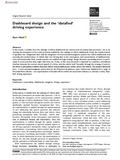Citation link:
http://dx.doi.org/10.25819/ubsi/10125| DC Field | Value | Language |
|---|---|---|
| crisitem.author.orcid | 0000-0001-8347-3695 | - |
| dc.contributor.author | Hind, Sam | - |
| dc.date.accessioned | 2022-06-09T07:51:53Z | - |
| dc.date.available | 2022-06-09T07:51:53Z | - |
| dc.date.issued | 2021 | de |
| dc.description | Finanziert aus dem Open-Access-Publikationsfonds der Universität Siegen für Zeitschriftenartikel | de |
| dc.description.abstract | In this article, I consider how the redesign of vehicle dashboards has restructured car-related data processes. I do so by charting the emergence of two such processes enabled by the redesign of vehicle dashboards: firstly, the transformation of ‘geodata’ into ‘navigational data’ with the integration of voice-activated navigation systems into vehicle dashboards, and secondly, the transformation of ‘vehicle data’ into ‘driving data’ in the convergence, and customization, of dashboard features and functionality. Both transformations are enabled through strategic design decisions, persuading drivers to participate in novel practices they might otherwise not. Firstly, in that voice-activation is depicted as a seamless, unmediated interface between the normal, natural speech of a driver, and the vehicle itself. Secondly, through the strategy of control, the driver is persuaded to believe they have full(er) customizable power within, and of, the vehicle. The systems discussed here – a voice-activated navigation system built on the What3words platform, and a ‘widescreen’ dashboard in a range of Mercedes-Benz vehicles – are representative of broader efforts within the automotive industry to cultivate a newly ‘datafied’ driving experience. | en |
| dc.identifier.doi | http://dx.doi.org/10.25819/ubsi/10125 | - |
| dc.identifier.uri | https://dspace.ub.uni-siegen.de/handle/ubsi/2214 | - |
| dc.identifier.urn | urn:nbn:de:hbz:467-22148 | - |
| dc.language.iso | en | de |
| dc.rights | Namensnennung 4.0 International | * |
| dc.rights.uri | http://creativecommons.org/licenses/by/4.0/ | * |
| dc.source | Big Data & Society ; 2021. - https://doi.org/10.1177/20539517211049862 | de |
| dc.subject.ddc | 302.23 Medien (Kommunikationsmittel), Medienwissenschaft | de |
| dc.subject.other | Datafication | en |
| dc.subject.other | Automobility | en |
| dc.subject.other | Dashboards | en |
| dc.subject.other | Navigation | en |
| dc.subject.other | Driving | en |
| dc.subject.other | Experience | en |
| dc.subject.swb | Armaturenbrett | de |
| dc.subject.swb | Automobil | de |
| dc.subject.swb | Datentransformation | de |
| dc.subject.swb | Verkehrstechnik | de |
| dc.title | Dashboard design and the ‘datafied’ driving experience | en |
| dc.type | Article | de |
| item.fulltext | With Fulltext | - |
| ubsi.source.author | GBI-Genios Deutsche Wirtschaftsdatenbank | de |
| ubsi.source.doi | 10.1177/20539517211049862 | - |
| ubsi.source.issn | 2053-9517 | - |
| ubsi.source.issued | 2021 | de |
| ubsi.source.pages | 14 | de |
| ubsi.source.place | Thousand Oaks | de |
| ubsi.source.publisher | Sage | de |
| ubsi.source.title | Big Data & Society | de |
| ubsi.source.volume | 2021 | de |
| ubsi.subject.ghbs | KNZT | de |
| Appears in Collections: | Geförderte Open-Access-Publikationen | |
Files in This Item:
| File | Description | Size | Format | |
|---|---|---|---|---|
| Hind_Dashboard_design.pdf | 10.14 MB | Adobe PDF |  View/Open |
This item is protected by original copyright |
Page view(s)
294
checked on Jan 11, 2025
Download(s)
81
checked on Jan 11, 2025
Google ScholarTM
Check
Altmetric
This item is licensed under a Creative Commons License


